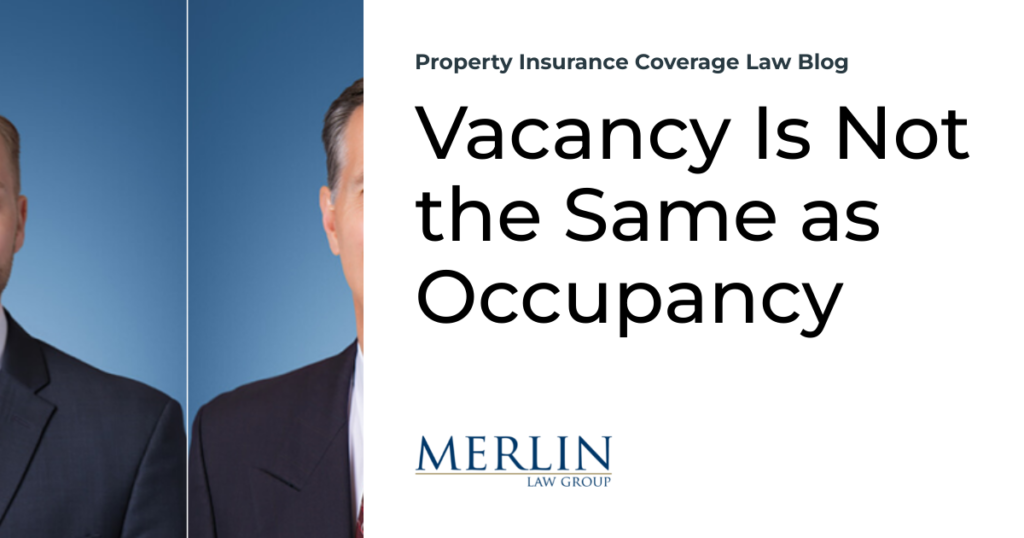Vacancy Is Not the Same as Occupancy

The post from yesterday, Developers, Commercial Owners, and Property Managers Need to Be Aware of Vacancy Clauses, had a response from insurance educator Bill Wilson. Wilson accurately noted the following:
Just as important is what constitutes ‘vacant.’ Traditionally, vacant meant no people and no contents to speak of. Then ISO changed the definition in their forms, as did many non-ISO insurers, so that a building can be partially occupied or possess considerable amounts of contents and be considered vacant.
Merlin Law Group attorney Ed Eshoo wrote an excellent post, What Constitutes a Dwelling or Building Under Construction or Renovation For Purposes of a Vacancy Exclusion? on this topic. He noted:
The typical vacancy provision in a commercial property policy is patterned after the ISO Building and Personal Property Form (BPP form). It excludes loss or damage caused by vandalism, sprinkler leakage, glass breakage, water damage, and theft or attempted theft if the building has been vacant for more than 60 consecutive days. For all other covered causes of loss, including fire, the carrier will reduce payment by 15 percent if the building has been vacant for more than 60 consecutive days before the loss occurs.
Vacancy provisions in homeowners and commercial property policies typically state that properties ‘being constructed,’ ‘in the process of construction,’ ‘under construction,’ ‘under renovation,’ or ‘under construction or renovation’ are not considered vacant. ‘Construction’ is not limited to the erection of a new structure; it contemplates ‘renovation,’ ‘remodeling,’ and ‘additions,’ although those terms usually are not defined. Courts have concluded that when “renovation” is used in conjunction with ‘construction,’ it includes any activity that restores the property to its former condition, such as repairing broken waterlines, repairing or replacing damaged ceiling tiles, toilets, and porches, and replacing drywall or a roof. Under this interpretation, a broad range of construction or renovation activity would prevent a property from being deemed vacant.
…
Homeowners property policies usually do not define ‘vacant’ or ‘unoccupied,’ so courts give those terms their plain and ordinary meaning. Although they are frequently used interchangeably, the terms have different meanings: vacant means empty or without contents, and unoccupied means the lack of people’s habitual presence.
…
Under the ISO BPP form, the definition of vacant depends on whether the policy is issued to a building owner or a tenant. For owners, the property is considered the entire building, and it is vacant unless a lessee or sub-lessee rents at least 31 percent of its total square footage and uses it to conduct customary business operations, or the building owner uses it to conduct customary operations. For tenants, the building is the unit the tenant rents, and it is vacant when the premises do not contain enough business personal property to conduct customary operations.
Yesterday’s post noted the insurance company’s motion regarding the vacancy issue. Earlier in the case, the policyholder’s attorney referenced and cited for authority a post made by Merlin Law Group attorney Larry Bache in 2011. That post,Insurers Continually Confuse the Term “Vacancy” With the Term “Unoccupancy.” What Is the Difference?, made the following point:
‘Vacant’ and “unoccupied’ are not synonymous. ‘Vacant’ means entirely empty (i.e., lack of animate or inanimate objects), while ‘unoccupied’ means the lack of habitual presence of human beings (i.e., lack of animate objects). This construction has been followed by courts throughout the country.
…
The difference between the definitions of the terms is critical if a policy contains a ‘vacancy’ exclusion, but not an ‘unoccupancy’ exclusion. It is important for policyholders to know the difference because many insurance claims adjusters do not. This results in regular wrongful denials of insurance benefits.
Perhaps the best example of an unoccupied, but not vacant structure, would be a fully furnished Tampa Bay home owned by a New York resident who resides in Tampa Bay for only three months during the winter. Such a home would be unoccupied for the remainder of the year, but since the house is filled with all the inanimate objects customarily found in a home, it probably would not be classified as “vacant.”
Certain policies include a ‘vacancy’ exclusion and others include a ‘vacant, unoccupied, or uninhabited’ exclusion. The latter is much more common and constitutes a much broader exclusion. In fact, some courts allow these terms to be used interchangeably if this specific exclusion is within the policy. Unfortunately, some claims handlers apply the ‘vacant, unoccupied, or uninhabited’ exclusion to the much more narrow ‘vacancy’ exclusion. The results are disastrous, requiring policyholders to fight for the benefits owed under their policies.
The bottom line for all policyholders is to be aware of which exclusion is in their policy. If they choose to leave their building for an extended period of time, it is important to contact the insurer and determine whether the building will remain covered by the current policy or whether they will need to purchase different coverage.
It is quite remarkable that other attorneys, and sometimes judges, cite to this blog as legal authority. Since it is quite public and available for critique and comment by readers, it certainly passes the peer review test. We appreciate our readers and your views. When you read something and feel compelled to write something in response, please do so. The comments at the end of the posts add significantly to the discussion.
Thought For The Day
Moral science is better occupied when treating of friendship than of justice.
—Thomas Aquinas







